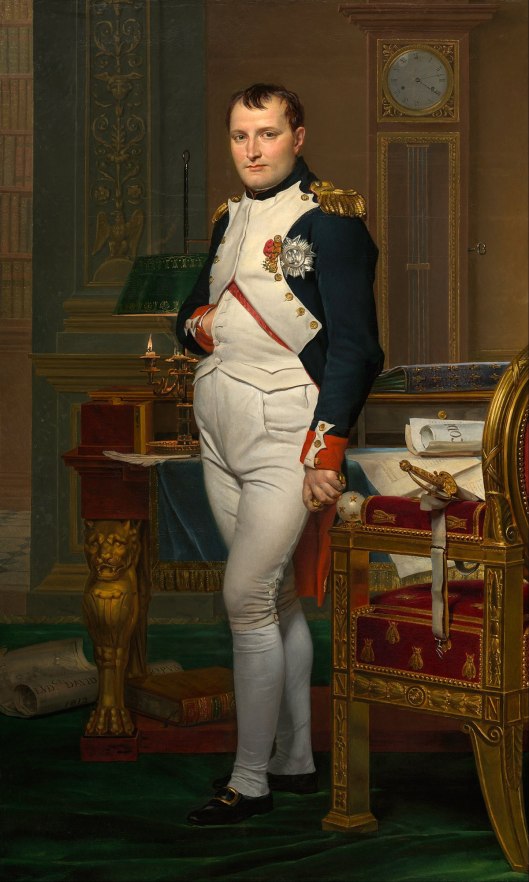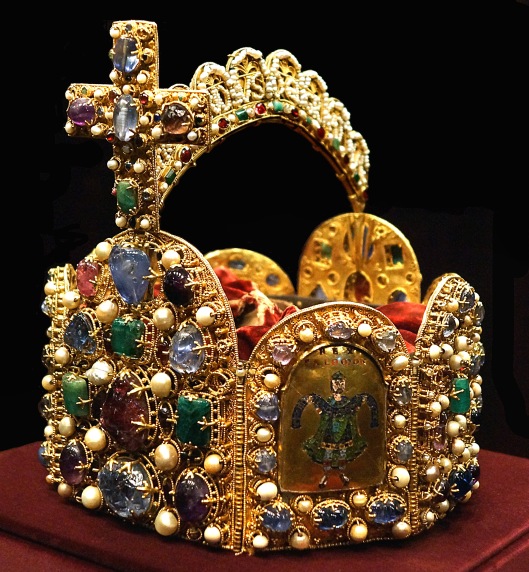From the Emperor’s Desk: In this examination of King Carl XIV-III Johan of Sweden and Norway I will cover his marriage and election to the Swedish throne.
Incidentally, when I began studying royalty I was interested in knowing if the Britis Crown had been passed down in the same family or did they ever bring in a family that was totally unrelated by Blood to previous monarchs. Although this is not Britain, for life of the future King of Sweden demonstrates such a case.
Carl XIV-III Johan (January 26, 1763 – March 8, 1844) was King of Sweden and Norway from 1818 until his death in 1844. Before his reign he was a Marshal of France during the Napoleonic Wars and participated in several battles. In modern Norwegian lists of kings he is called Carl III Johan. He was the first monarch of the Bernadotte dynasty.
Jean-Baptiste Jules Bernadotte was born on 26 January 26, 1763 in Pau, the capital of the province of Béarn in the southwestern part of the Kingdom of France. He was the son of Jean Henri Bernadotte (1711–1780), prosecutor at Pau, and his wife, Jeanne de Saint-Jean (1728–1809).
The family name was originally du Poey (or de Pouey), but was changed to Bernadotte—a surname of an ancestress at the beginning of the 17th century. He was the youngest of five siblings, two of whom died in childhood. Soon after his birth, Baptiste was added to his name, to distinguish him from his elder brother Jean Évangeliste. Bernadotte himself added Jules to his first names as a tribute to the French Empire under Napoleon I.

Carl XIV-III Johan, King of Sweden and Norway
Bernadotte joined the French Royal Army in 1780. Following the outbreak of the French Revolution, he exhibited great military talent, rapidly rising through the ranks, and was made a brigadier general by 1794. He served with distinction in Italy and Germany, and was briefly Minister of War.
His relationship with Napoleon was turbulent; nevertheless, Napoleon named him a Marshal of the Empire on the proclamation of the French Empire. Bernadotte played a significant role in the French victory at Austerlitz, and was made Prince of Pontecorvo as a reward.
Marriage
Désirée Clary was born in Marseille, France, the daughter of François Clary (February 24, 1725 – January 20, 1794), a wealthy silk manufacturer and merchant, by his second wife Françoise Rose Somis (1737 – 1815).
Clary had a sister and brother to whom she remained very close all her life. Her sister, Julie Clary, married Joseph Bonaparte, and later became Queen of Naples and Spain. Her brother, Nicholas Joseph Clary, was created Count Clary. He married Anne Jeanne Rouyer, by whom he had a daughter named Zénaïde Françoise Clary (1812 – 1884). Zénaïde would marry Napoléon Alexandre Berthier, the son of Marshal Louis Alexandre Berthier, and have several children, among them the first wife of Joachim, 4th Prince Murat.

Désirée, Queen of Sweden and Norway
She received a proposal from General Junot, but turned it down because it was given through Marmont. Clary eventually met her future spouse, Jean Baptiste Jules Bernadotte, another French general and politician. They were married in a secular ceremony at Sceaux on August 17, 1798. In the marriage contract, Clary was given economic independence. On July 4, 1799, she gave birth to their only child, a son, Oscar.
In 1810 Bernadotte was about to enter his new post as governor of Rome when he was unexpectedly elected the heir-presumptive to King Carl XIII-II of Sweden and Norway. The problem of Carl’s successor had been acute almost from the time he had ascended the throne a year earlier.
The King was 61 years old and in poor health. He was also childless; Queen Elizabeth Charlotte had given birth to two children who had died in infancy, and there was no prospect of her bearing another child.
Queen Elizabeth Charlotte was daughter of Duke Friedrich August I of Holstein-Gottorp and Princess Ulrike Friederike of Hesse-Cassel.
Soon after his coronation, the king had adopted a Danish prince Carl August, (originally Prince Christian August of Denmark).
Prince Christian August was the son of Friedrich Christian I, Duke of Schleswig-Holstein-Sonderburg-Augustenburg (1721–1794) and Princess Charlotte of Schleswig-Holstein-Sonderburg-Plön (1744–1770).

Carl XIII-II, King of Sweden and Norway
He was a younger brother of Friedrich Christian II, Duke of Augustenborg, brother-in-law of Princess Louise Auguste of Denmark “daughter” of King Christian VII of Denmark and Caroline Matilda of Great Britain and an uncle of Caroline Amalie of Augustenburg, Queen Consort of Denmark as the wife of Christian VIII and Christian August, Duke of Augustenborg. He did not marry.
Despite the fact that Napoleon favored his ally Danish King Frederik VI, Danish Prince Frederick Christian initially had the most support to become Swedish Crown Prince as well.
As Crown Prince of Sweden, Prince Christian August changed his name to Carl August. Honors were lavished upon him on his arrival, he was for example made an honorary member of the Royal Swedish Academy of Sciences on April 18, 1810, and was the first person to enjoy this status in that academy.
However, he did not live long enough to make a historical impact in Sweden. He suddenly died on 28 May 28, 1810, when he fell off his horse during a military practice in Kvidinge. His autopsy confirmed that he had died of a stroke, but at the same time rumours went that he had been poisoned by Gustavians.
Specifically, the Marshal of the Realm Count Axel von Fersen was openly accused of having killed Crown Prince Carl August, and was lynched on June 20, 1810 during the funeral procession of Carl August. Carl August was buried in Riddarholmen Church, the burial church of Swedish monarchs.
The political situation internally and externally for Sweden meant that selecting a foreign king was an attractive option. Sweden wanted to strengthen its relationship with Napoleon for militaristic reasons so sought to select a king who would be able to attract Napoleon’s support.
The Swedish court initially sounded out the emperor for his preferences on candidates for crown prince, whereupon Napoleon made it clear he preferred his adopted stepson Eugène de Beauharnais, or one of his nephews or brothers.
The Swedish envoys did not accept Eugène as a candidate. Baron Lagerbielke, the Swedish envoy in Paris, reported to Stockholm that Eugène was “gentle and good,” “but he does not seem to be a man of strong character; and, although he had had great opportunities, he does not appear to have developed any distinguishing talents.”
Also, Eugène, serving as viceroy in Italy, did not wish to convert to Lutheranism, a prerequisite for accepting the Swedish offer. Moreover, none of Napoleon’s brothers were interested in going to Sweden and his nephews were too young, as the Swedes did not want the hazards of minority rule in the event King Carl XIII died prematurely.
The matter was decided by an obscure Swedish courtier, Baron Karl Otto Mörner (nephew of Count Gustav Mörner, the commander of the Swedish force captured by Bernadotte at Lübeck), who, entirely on his own initiative, offered the succession to the Swedish crown to Bernadotte.

Carl XIV-III Johan, King of Sweden and Norway
Bernadotte communicated Mörner’s offer to Napoleon who at first treated the situation as an absurdity, but later came around to the idea and supported Bernadotte’s candidacy both financially and diplomatically.
Although the Swedish government, amazed at Mörner’s effrontery, at once placed him under arrest on his return to Sweden, the candidature of Bernadotte gradually gained favour and on August 21, 1810 he was elected by the Riksdag of the Estates in Örebro to be the new crown prince, and was subsequently made Generalissimus of the Swedish Armed Forces by the King.
Several factors benefitted Bernadotte’s election. Being foreign was, although problematic, also to his favour due to geopolitical factors and the internal situation at the time. One benefit was his (presumed) close ties to French Emperor Napoleon Bonaparte, with whom a relationship would provide military backing as the intention at the time was to reacquire Finland.
The current King, Carl XIII, viewed Napoleon in a more positive way than the deposed King, Gustaf IV Adolph had, who had held him in very ill regard. Another point in favour was that a large part of the Swedish Army, anticipating conflict with Russia, were in favour of electing a soldier.

Also, Bernadotte was personally popular, owing to the kindness he had shown to the Swedish prisoners in Lübeck and his reputation as the well-liked governor of the Hanseatic Cities from 1807 to 1809; as many Swedish merchants had operated under his auspices.
Finally, Bernadotte had no qualms about converting to Lutheranism, recalling the conversion of King Henri IV for the benefit of France with whom he felt a kinship with as both hailed from Pau, nor converting his son Oscar (though his wife Désirée never did renounce Catholicism).
Before freeing Bernadotte from his allegiance to France, Napoleon asked him to agree never to take up arms against France. Bernadotte refused to make any such agreement, upon the ground that his obligations to Sweden would not allow it; Napoleon exclaimed “Go, and let our destinies be accomplished” and signed the act of emancipation unconditionally.
On November 2, 1810 Bernadotte made his solemn entry into Stockholm, and on November 5, he received the homage of the Riksdag of the Estates, and he was adopted by King Carl XIII under the name of “Carl Johan.”
At the same time, he converted from Roman Catholicism to the Lutheranism of the Swedish court; Swedish law required the monarch to be Lutheran.
soon after his arrival becoming de facto head of state for most of his time as Crown Prince. In 1813, following the sudden unprovoked French invasion of Swedish Pomerania, Crown Prince Carl Johan was instrumental in the creation of the Sixth Coalition by allying with Emperor Alexander I of Russia and using Swedish diplomacy to bring warring Russia and Britain together in alliance. He then authored the Trachenberg Plan, the war-winning Allied campaign plan, and commanded the Allied Army of the North that defeated two concerted French attempts to capture Berlin and made the decisive attack on the last day of the catastrophic French defeat at Leipzig.
After the War of the Sixth Coalition, Crown Prince Carl Johan forced King Frederik VI of Denmark to cede Norway to Sweden, leading to the Swedish–Norwegian War of 1814 where Norway was defeated after a single summer’s conflict. This put Norway into a union with Sweden, which lasted for almost a century before its peaceful 1905 dissolution. The Swedish–Norwegian war is credited as Sweden’s last direct conflict and war.
Upon the death of King Carl XIII-II in 1818, Crown Prince Carl Johan ascended to the thrones as King Carl XIII-II Johan of Sweden and Norway. He presided over a period of peace and prosperity, and reigned until his death in 1844.























